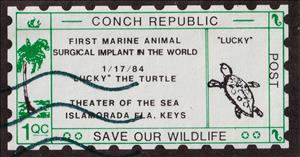Stamp: Lucky (Cinderellas 1984)
Lucky (Cinderellas 1984)
17 January (Cinderellas ) within release U.S.A. - Conch Republic (Key West, FL) goes into circulation Stamp Lucky face value 1 Fantasy
| Stamp Lucky in catalogues | |
|---|---|
| Colnect codes: | Col: US-CR 1984/1 |
Stamp is horizontal format.
Value 1 Queen Conch = 100 Conch. Commemorates "First marine animal surgical implant in the World. 1/17/84. 'Lucky' the turtle. Theater of the Sea, Islamorada Fla. Keys."|
Data entry completed
90%
|
|
|---|---|
| Stamp Lucky in digits | |
| Country: | Cinderellas |
| Date: | 1984-01-17 |
| Print: | Recess |
| Size: | 67 x 35.5 |
| Perforation: | Imperforate |
| Emission: | Cinderella |
| Format: | Stamp |
| Face Value: | 1 Fantasy |
Stamp Lucky it reflects the thematic directions:
Marine mammals are mammals that rely on marine (saltwater) ecosystems for their existence. They include animals such as cetaceans (whales, dolphins and porpoises), pinnipeds (seals, sea lions and walruses), sirenians (manatees and dugongs), sea otters and polar bears. They are an informal group, unified only by their reliance on marine environments for feeding and survival.
Marine life, or sea life or ocean life, refers to the plants, animals and other organisms that live in the salt water of the sea or ocean, or the brackish water of coastal estuaries. At a fundamental level, marine life helps determine the very nature of our planet. Marine organisms produce much of the oxygen we breathe. Shorelines are in part shaped and protected by marine life, and some marine organisms even help create new land. Altogether there are 230,000 documented marine species, including over 16,000 species of fish, and it has been estimated that nearly two million marine species are yet to be documented. Marine species range in size from the microscopic, including plankton and phytoplankton which can be as small as 0.02 micrometres, to huge cetaceans (whales, dolphins and porpoises) which in the case of the blue whale reach up to 33 metres (109 feet) in length, being the largest known animal.
Turtles are reptiles of the order Testudines, characterized by a special shell developed mainly from their ribs. Modern turtles are divided into two major groups, the Pleurodira (side necked turtles) and Cryptodira (hidden necked turtles), which differ in the way the head retracts. There are 360 living and recently extinct species of turtles, including land-dwelling tortoises and freshwater terrapins. They are found on most continents, some islands and, in the case of sea turtles, much of the ocean. Like other amniotes (reptiles, birds, and mammals) they breathe air and do not lay eggs underwater, although many species live in or around water.



